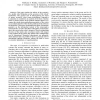Free Online Productivity Tools
i2Speak
i2Symbol
i2OCR
iTex2Img
iWeb2Print
iWeb2Shot
i2Type
iPdf2Split
iPdf2Merge
i2Bopomofo
i2Arabic
i2Style
i2Image
i2PDF
iLatex2Rtf
Sci2ools
ICRA
2005
IEEE
2005
IEEE
Optimal Formations for Cooperative Localization of Mobile Robots
— This paper studies the effects of the geometry of a mobile robot formation on the accuracy of the robots’ localization. The general case of heterogeneous (in terms of sensor accuracy) robot teams performing Cooperative Localization is considered. An analysis of the time evolution of the covariance matrix of the position estimates allows us to express the steady-state positioning uncertainty of the robots as an analytic function of the relative positions of the robots in the formation. This metric encapsulates the effect of formation geometry on the information content of the exteroceptive measurements, as well as the effect of the influx of uncertainty due to the errors in the robots’ odometry. Thus, by minimizing the trace of the steady state covariance matrix with respect to the positions of the robots, the optimal robot configuration can be determined. Numerical experiments are presented, which indicate that it is possible to derive a practical rule for determining optimal...
| Added | 25 Jun 2010 |
| Updated | 25 Jun 2010 |
| Type | Conference |
| Year | 2005 |
| Where | ICRA |
| Authors | Yukikazu S. Hidaka, Anastasios I. Mourikis, Stergios I. Roumeliotis |
Comments (0)

